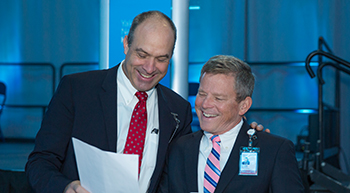
Drs. Thomas Balcezak, YNHHS chief medical officer, and Michael Ivy, YNHHS deputy CMO, shared the stage in a discussion of quality and safety efforts at YNHHS.
"As we look forward to fiscal year 2017, how do we continue to advance quality and health safety across the Health System?" asked Thomas Balcezak, MD, YNHHS and YNHH chief medical officer. "These efforts are based on our desire to achieve the 'triple aim' – better value, better health care and better health – for our patients as individuals and for our communities."
YNHHS's 2017 safety and quality priorities:
- Infection prevention standardization: The YNHHS Infection Prevention Committee will welcome members of L+M Healthcare. Also, in order to reduce hospital-acquired infections, YNHHS is creating an infection control manual to help standardize processes at all locations.
- Surveillance and prevention: The Health System will standardize surveillance processes and the use of evidence-based interventions to support safety.
- Anti-microbial stewardship: One of the foundations of our C. difficile prevention work is to prevent the overuse of antibiotics, especially in the outpatient setting.
Said Balcezak, "When we function as a health system, we all gain because we do things the same way and create evidence-based protocols that look and feel the same, and provide that signature service to our patients across the health system."
"Back in the 1970s, industries like naval aviation and nuclear power studied safety and made a science out of understanding human error," said Michael Ivy, MD, YNHHS deputy chief medical officer and CMO at Bridgeport Hospital. "Fast forward to the present and see how health care has benefited. The same principles that help land a plane on an aircraft carrier safely also make it safer to perform a liver transplant."
In 2012, YNHHS began its journey to become a High Reliability Organization by implementing a number of processes – ongoing training, rounding to influence staff, sharing safety stories, training safety coaches, studying metrics and outcomes, and applying fair and just accountability. Clinical redesign has been another factor in making YNHHS safer and more cost effective. Highlights include reducing length of stay, which frees up beds for other patients; better, safer use of ancillary testing; improving surgical recovery time and outcomes; care transitions; and hospice and palliative care. "Clinical redesign focuses on processes to make outcomes more efficient, safer and better for the patient," said Dr. Ivy.
